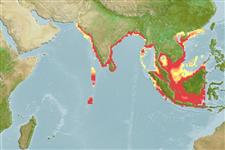Common names from other countries
Environment: milieu / climate zone / depth range / distribution range
Ecologie
; brakwater; diepteverspreiding 4 - 90 m (Ref. 8). Tropical; 26°N - 9°S, 62°E - 118°E
Indo-West Pacific: from Pakistan to Vietnam and Borneo.
Length at first maturity / Size / Gewicht / Leeftijd
Maturity: Lm ? range ? - ? cm Max length : 15.2 cm TL mannelijk/geslacht niet bekend; (Ref. 8); common length : 13.0 cm TL mannelijk/geslacht niet bekend; (Ref. 8)
Juveniles are found in mangrove inlets, intertidal and subtidal edge of mud flats, near inshore and far inshore waters (Ref. 121464). Found in seagrass, sand and among shells (Ref. 121467).
Life cycle and mating behavior
Geslachtsrijpheid | Voortplanting | Kuitschieten | Eieren | Fecundity | Larven
Members of the order Decapoda are mostly gonochoric. Mating behavior: Precopulatory courtship ritual is common (through olfactory and tactile cues); usually indirect sperm transfer.
Holthuis, L.B. 1980. (Ref. 8)
Status op de Rode Lijst van het IUCN (Ref. 130435)
Status bij CITES (Ref. 108899)
Not Evaluated
Not Evaluated
Gebruik door de mens
Visserij: commercieel
| FishSource | Sea Around Us
Tools
Internet-bronnen
Estimates based on models
Preferred temperature
(Ref.
115969): 26.5 - 29.1, mean 28.3 (based on 1550 cells).
Weerstandsvermogen
Hoog, minimale populatieverdubbelingstijd minder dan 15 maanden (K=0.87-0.93).
Kwetsbaarheid
Low vulnerability (15 of 100).
